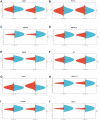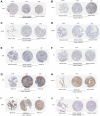Exosomal hsa-miR-151a-3p and hsa-miR-877-5p are potential novel biomarkers for predicting bone metastasis in lung cancer
- PMID: 38180107
- PMCID: PMC10781484
- DOI: 10.18632/aging.205314
Exosomal hsa-miR-151a-3p and hsa-miR-877-5p are potential novel biomarkers for predicting bone metastasis in lung cancer
Abstract
Exosomal miRNAs (exo-miRNAs) have arisen as novel diagnostic biomarkers for various cancers. However, few reports on exo-miRNAs related to bone metastasis (BM) in lung cancer exist. This study aims to screen out key exo-miRNAs and estimate their prognostic values for predicting BM in lung cancer. The differentially expressed exo-miRNAs between the highly-metastatic (95D) and lowly-metastatic (A549) human lung cancer cell lines were comprehensively analyzed using high-throughput sequencing followed by bioinformatic analyses. 29 candidate exo-miRNAs were identified, and 101 BM-related target genes were predicted. Enrichment analysis revealed that these target genes were mainly involved in regulating transcription and pathways in cancer. An exosomal miRNA-mRNA regulatory network consisting of 7 key miRNAs and 10 hub genes was constructed. Further function analysis indicated that these 10 hub genes were mainly enriched in regulating cancer's apoptosis and central carbon metabolism. The survival analysis indicated that 7 of 10 hub genes were closely related to prognosis. Mutation analysis showed that lung cancer patients presented certain genetic alterations in the 7 real hub genes. GSEA for a single hub gene suggested that 6 of 7 real hub genes had close associations with lung cancer development. Finally, ROC analysis revealed that hsa-miR-151a-3p and hsa-miR-877-5p provided high diagnostic accuracy in discriminating patients with bone metastasis (BM+) from patients without bone metastasis (BM-). These findings provided a comprehensive analysis of exo-miRNAs and target genes in the regulatory network of BM in lung cancer. In particular, hsa-miR-151a-3p and hsa-miR-877-5p may be novel biomarkers for predicting BM in lung cancer.
Keywords: biomarker; bone metastasis; exosome; lung cancer; miRNAs.
Conflict of interest statement
Figures











Similar articles
-
Using biological information to analyze potential miRNA-mRNA regulatory networks in the plasma of patients with non-small cell lung cancer.BMC Cancer. 2022 Mar 21;22(1):299. doi: 10.1186/s12885-022-09281-1. BMC Cancer. 2022. PMID: 35313857 Free PMC article.
-
Construction and diagnostic efficacy assessment of the urinary exosomal miRNA-mRNA network in children with IgA vasculitis nephritis.FASEB J. 2025 Apr 15;39(7):e70492. doi: 10.1096/fj.202403111R. FASEB J. 2025. PMID: 40166907 Free PMC article.
-
Identification of non-invasive biomarkers for chronic atrophic gastritis from serum exosomal microRNAs.BMC Cancer. 2019 Feb 8;19(1):129. doi: 10.1186/s12885-019-5328-7. BMC Cancer. 2019. PMID: 30736753 Free PMC article.
-
A Next-Generation Sequencing of Plasma Exosome-Derived microRNAs and Target Gene Analysis with a Microarray Database of Thermally Injured Skins: Identification of Blood-to-Tissue Interactions at Early Burn Stage.J Inflamm Res. 2021 Dec 10;14:6783-6798. doi: 10.2147/JIR.S343956. eCollection 2021. J Inflamm Res. 2021. PMID: 34916825 Free PMC article.
-
Progress in Precision Medicine for Head and Neck Cancer.Cancers (Basel). 2024 Nov 4;16(21):3716. doi: 10.3390/cancers16213716. Cancers (Basel). 2024. PMID: 39518152 Free PMC article. Review.
Cited by
-
In Silico Identification of Dysregulated miRNAs Targeting KRAS Gene in Pancreatic Cancer.Diseases. 2024 Jul 12;12(7):152. doi: 10.3390/diseases12070152. Diseases. 2024. PMID: 39057123 Free PMC article.
-
Nonylphenol promotes epithelial-mesenchymal transition in colorectal cancer cells by upregulating miR-151a-3p.Discov Oncol. 2025 Jan 20;16(1):63. doi: 10.1007/s12672-025-01805-y. Discov Oncol. 2025. PMID: 39832042 Free PMC article.
-
New insights into non-small cell lung cancer bone metastasis: mechanisms and therapies.Int J Biol Sci. 2024 Oct 21;20(14):5747-5763. doi: 10.7150/ijbs.100960. eCollection 2024. Int J Biol Sci. 2024. PMID: 39494330 Free PMC article. Review.
-
Serum exosomal miRNA contributes to the diagnosis of leptomeningeal carcinomatosis.J Neurooncol. 2025 Jun;173(2):419-428. doi: 10.1007/s11060-025-04999-x. Epub 2025 Mar 13. J Neurooncol. 2025. PMID: 40080246 Free PMC article.
-
The rs3757385 polymorphism increases IRF5 expression and systemic nitric oxide metabolites, protecting urothelial bladder cancer patients from recurrence.Mol Biol Rep. 2025 Jun 28;52(1):649. doi: 10.1007/s11033-025-10738-2. Mol Biol Rep. 2025. PMID: 40580227
References
Publication types
MeSH terms
Substances
LinkOut - more resources
Full Text Sources
Medical

